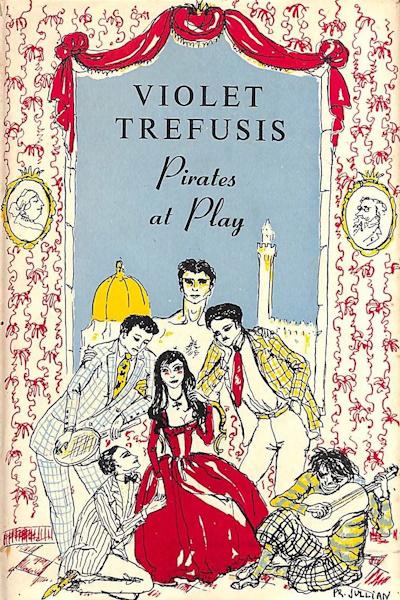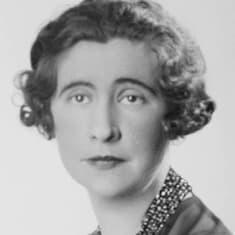Review by Frances S: Violet Trefusis, (1894-1972), was the daughter of Alice Keppel, wife of George Keppel, a son of the 7th Earl of Albemarle. When Violet was four years old, her mother became the favorite mistress of the then Prince of Wales (later King Edward VII). Violet grew up as a cosmopolitan socialite and became a writer, part of the notoriously avant-garde ‘Bloomsbury Set’. She was fluent in French and wrote in both French and English.

Billed as a ‘romantic comedy’, and set in 1929, Pirates at Play centres on two families: the English aristocratic Caracoles (pronounced ‘Crackles’), and the wealthy, middle class, Italian Papagalli. The latters’ status comes from Signor Papagallo’s position as a Papal Count, a title he has acquired as the Pope’s dentist. Trefusis knew whereof she wrote: the English country house set and the Florentine society she describes in vivid and entertaining detail are her own milieux.
Pirates at Play opens in Florence, where several of the six Papagalli children are engaged in lively banter about their family. They are clearly aware of what they (and, presumably, Trefusis) see as the banality of their father’s profession, amusing themselves by thinking of possible features of a family crest. Centre of attention is, as always, Ludovica (known as Vica), the very beautiful daughter who is beginning to discover her power:
The scene shifts to England, where Lord and Lady Canterdown, parents of Elizabeth Caracole, are preparing to send her to stay with the Papagalli to learn Italian. Elizabeth (Liza), is a golden-haired English beauty, brought up in the kind of English country house familiar to Trefusis and her friends.
Liza arrives in Florence and the two beautiful girls, one dark, the other fair, seem to get on with each other. There is a surprising lack of either animosity or close friendship between them, especially as Liza inspires admiration from Vica’s beloved brothers, and before long a marriage proposal from Gian, the man Vica herself desires. Both girls seem to take it for granted that marriage to a suitable man will be their role in life.
Gian is the nephew of a formidable Spanish Principessa. Unfortunately for Gian and Vica, the Principessa considers a dentist’s daughter unacceptable as a future niece in law. The Principessa does, however, approve of a relationship between Gian and a member of the English aristocracy. Englishness, to Liza’s initial surprise, is much admired by the Italians.
Liza allows herself to be swept into an engagement with Gian. Liza’s brother Charles arrives on a visit and inevitably falls in love with Vica at first sight. The two couples become engaged.
Liza’s parents are horrified at the prospect of an Italian son-in-law. Equally appalled is Peter, best friend of Liza’s brother Charles, who has been devoted to Liza since childhood. Encouraged by the Caracoles, Peter rushes over to Florence and persuades Liza to break off her engagement and return to England as his bride. The two couples travel together to England and there is a double wedding in the Caracoles’ parish church. Liza is now safely back in her home environment. Vica, discomforted from the beginning by the sparse Church of England wedding ceremony, tries, unsuccessfully as it turns out, to live the life of a minor English aristocrat’s wife in a large country house.
We see England through Vica’s bewildered eyes. In a sparkling letter to her favorite brother, Guido, the English and the Italians are skewered with equal acerbity:
Trefusis continues her teasing portrait of English upper-class life through Vica’s observations, rendered in free indirect speech.
Sadly, the dire English weather gets the better of Vica and she becomes seriously ill with pneumonia. Returning to Florence to recuperate, she reunites with Gian and must choose between him and her husband.
Pirates at Play is a fairly straightforward romance, but with no assumption of long-term happy endings. The title suggests that the central characters in the book are entertaining themselves at the expense of others – as is the relentless Trefusis.
The novel is full of interesting, but disappointingly undeveloped, characters. Vica’s five brothers include the homosexual Mario, Guido, whose love for his sister is disturbingly close to incestuous, and Rigo, who has fallen into the role of family buffoon because he has a disproportionate, dwarfish, body shape.
Vica’s father, content with his job, loathes the demands of his acquired rank and his wife’s social ambitions. Vica’s mother was the daughter of an Irishwoman who had come to Italy to live in Naples as companion to an ailing British dowager, and had then married her employer’s estate manager. The family had only moved from the life they all enjoyed in Naples because Vica’s mother considered Florence more suitable for their rank. But the Countess, for all her aspirations, must have had a kind heart. She gave a home as ‘governess’ to her dressmaker, a Frenchwoman who had lost her heart and all her cash to a faithless Italian lover.
Liza’s brother Charles is well meaning but aware that he is not very bright. His friend, Peter, is cleverer. Lord Canterdown, has been a roué most of his life, including throughout his marriage, and has a dry sense of humor. His wife has remarkable forbearance and their marriage has survived, but we learn little about the relationship.
There are other characters with great promise but who are presented almost as caricatures: the Caracole household includes a stereotypical sibylline nanny and her arch rival the equally stereotypical French ‘Madamzell’. There is a much put-upon unmarried cousin Francie, who chaperones Liza on the journey to Italy. Liza’s spectacularly unspinsterish elderly (around sixty!) Aunt Sybil, has a flamboyantly unmarried love life that excites admiration in her family but shocks Vica.
I would have liked to have been given the chance to get to know all these people better.
Most of the comedy comes from the author’s determinedly witty observations on her characters and their lives. This makes it difficult to warm to the book, even as one enjoys the clever writing.

